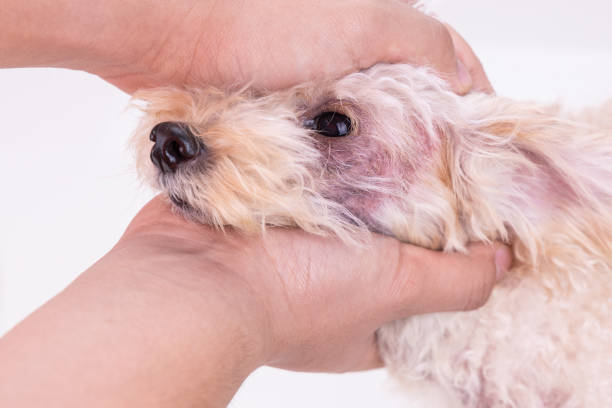The issue of flea infestation is a familiar problem for many pet owners, which can result in serious outbreaks in both people and their pets. Take a look at this handy guide which helps you determine the optimal time for considering flea protection for your dog.
The first time you need to think about flea control for your pet is when it has reached puppyhood. This is since puppies are more likely to bring home fleas from their environment or get them from other dogs. Once they’re fully grown, most pet owners don’t have to worry about this issue again until they’re adult dogs!
Flea control becomes an even greater concern when there is a high incidence of fleas in the area where your dog lives or spends most of its time. For example, if you live in a city with a large population of stray dogs, fleas are likely abundant, and your pet will need regular flea control to stay healthy.


When are Fleas Active?
Changes in the weather can also lead to more frequent treatments. Fleas are thought to become more active following heavy rain or humidity as they breed in a moist environment. Hot weather also causes fleas to become more active and so your dog may need pest control more often in the summer months.
One final factor you should consider is if your pet spends time outdoors. It will be much easier for them to contact fleas or their eggs when they do, increasing the chances of infestation. In this case, you are advised to treat your pet with a monthly preventative at least once every three months.
Pets that spend a lot of their time indoors can still become affected by fleas, but the risk is lower as they will typically come into contact with fewer adult fleas or eggs than those who spend more time outside. In this case, you should still ensure that you use a monthly treatment and pay close attention to those high-risk months.


If your pet has recently had a flea infestation, the effects of the infestation will likely take some time to wear off. This means that your dog may need more frequent treatments until they are completely free from future infestations.
Another factor you should consider is if your dog has certain health conditions that can make them more susceptible to the effects of fleas and other parasites. For example, older dogs often have weaker immune systems than younger pets and can be more badly affected by fleabites and eggs. In this case, it is advised to use a monthly treatment throughout the flea season.
If your dog is on medication that weakens their immune system, such as steroids, it is also advisable to treat them with flea control more regularly, both in high-risk environments and situations where you know there are adult fleas around. If you have any concerns about the frequency of your dog’s treatment, speak to your veterinarian.


It would help to consider whether you are transitioning to a new place with a high likelihood of flea infestation. If this is the case, you will likely need monthly preventative for at least six months so that you can clear all potential parasites from your dog’s environment and body before they move to a different place.
It is possible for dogs who spend most of their time indoors and are not at risk of exposure to become infested with fleas despite regular treatments. This usually occurs due to introducing an unsuitable new pet or human into your home that brings and activates dormant flea eggs or larvae buried away in your home.
In this case, you should still use a monthly treatment but pay even closer attention to your pet’s environment and remain vigilant about checking for signs of fleas or their eggs. If your dog starts to scratch or bite in strange patterns, visit the veterinarian immediately to check for infestation.
If you have used monthly treatments throughout the summer and the early fall only to find signs of flea infestation in your dog, you have likely missed a treatment. In this case, you should use the next available month for preventive treatments and then resume using monthly treatments after that time has passed.


How To Flea My Dog?
When it comes to fleas, prevention is always better than cure. Unfortunately, there are several limitations to what can be done to prevent your dog from becoming infected. You cannot stop them from rolling around on the ground to keep their fur clean, as they could still bring home eggs that have become stuck to grass or dirt. Overall, you have a limited amount of control over the likelihood of infestation, but you can best protect yourself by using a monthly treatment.
Of course, there will be times when your dog comes into contact with an adult flea or its eggs and is subsequently infested. It is important not to panic if this happens as most cases are easy to treat and resolve quickly if treated promptly. First, make sure your dog is brought inside and separated from other animals or humans in your household. It would be best to remove as many stray parasites as you can with a flea comb.


If you don’t have a flea comb available, it is possible to attempt removal by gently brushing against the fur pull off any fleas that you can see. If this is not possible, use a wet towel to wipe against your dog’s fur and skin in an attempt to remove as many of the stray parasites as you can.
Once you have gotten rid of most or all of the stray fleas you can see, check for eggs that may have become stuck to your dog’s fur. Flea eggs are creamy and often appear in small clusters around the base of hair follicles or other areas where they can attach to the skin.
If you come back from searching for your dog with flea eggs on its coat, you should go straight to the veterinarian so that they can prescribe the best treatment options for your case. If you cannot take the time to go to a veterinarian, be prepared to spend several days searching for hidden eggs and placing them in a watertight container so that they can be drowned before hatching into larvae.
If you cannot find stray eggs or adult fleas on your dog, the infestation may have ended after the first treatment. Keep a close watch on your dog for any signs of discomfort or scratching, and wash them regularly to keep them clean.


When treating your dog for a flea infestation, it is important to ensure that they are not allergic to the ingredients used in over-the-counter medications. Consulting with a veterinarian before buying any medication will help you avoid this situation and ensure that you are using a safe treatment for your dog.
If your dog is allergic to one type of flea prevention, be sure to try out the same or similar treatments with another pet first to make sure it does not cause an adverse reaction. If your dog has never been treated for a flea infestation, you will want to start with the most gentle treatment first. Anything that causes itching or discomfort should not be used on your pet until they have stopped showing any signs of reaction to a more mild treatment option.
What Signals Flea Control For My Dog?
You only need to think about flea control for your dog when they are a puppy. This is because puppies tend to carry fleas back from their environment or other dogs. Once your dog has reached adulthood, you typically do not need to worry about bringing home stray parasites as often.
It would be best to not give up on using flea prevention once your dog reaches maturity. This is because adult dogs are more likely to be bitten by a flea in their environment or encounter them during runs along with bushes. If your dog has not had any signs of fleas for six months, you can reduce the number of monthly treatments you give them but should still keep up with it at least once every three months.
What Should I Expect From Flea Prevention?
If you are using a topical treatment on your dog, it is common for them to have very minimal side effects. If you find that the medication leaves behind a greasy residue, try rubbing some baby powder or cornstarch into their coat before drying and brushing them. This will help keep their skin free from oily residue.
If your dog has an allergic reaction to the topical treatment, the veterinarian may recommend switching them to an oral medication instead. This will cause much fewer side effects but can be costly in the long run. Some dogs can switch back and forth between the two depending on their lifestyle, but you must always use a specific type of flea prevention for others.


Conclusion
The first thing you need to think about when it comes to flea prevention for your dog is whether or not they are a puppy. Once they reach adulthood, you don’t have as much of an issue but if you find stray eggs and adults on them, be sure to consult with the veterinarian before moving forward with any treatment plan.
If your pet has never been treated for fleas before, start using the gentlest possible option available because their skin can react poorly to harsh chemicals. Dogs who suffer from allergies must get tested with different treatments not to become allergic reactions in the future. For now, enjoy this handy guide.


